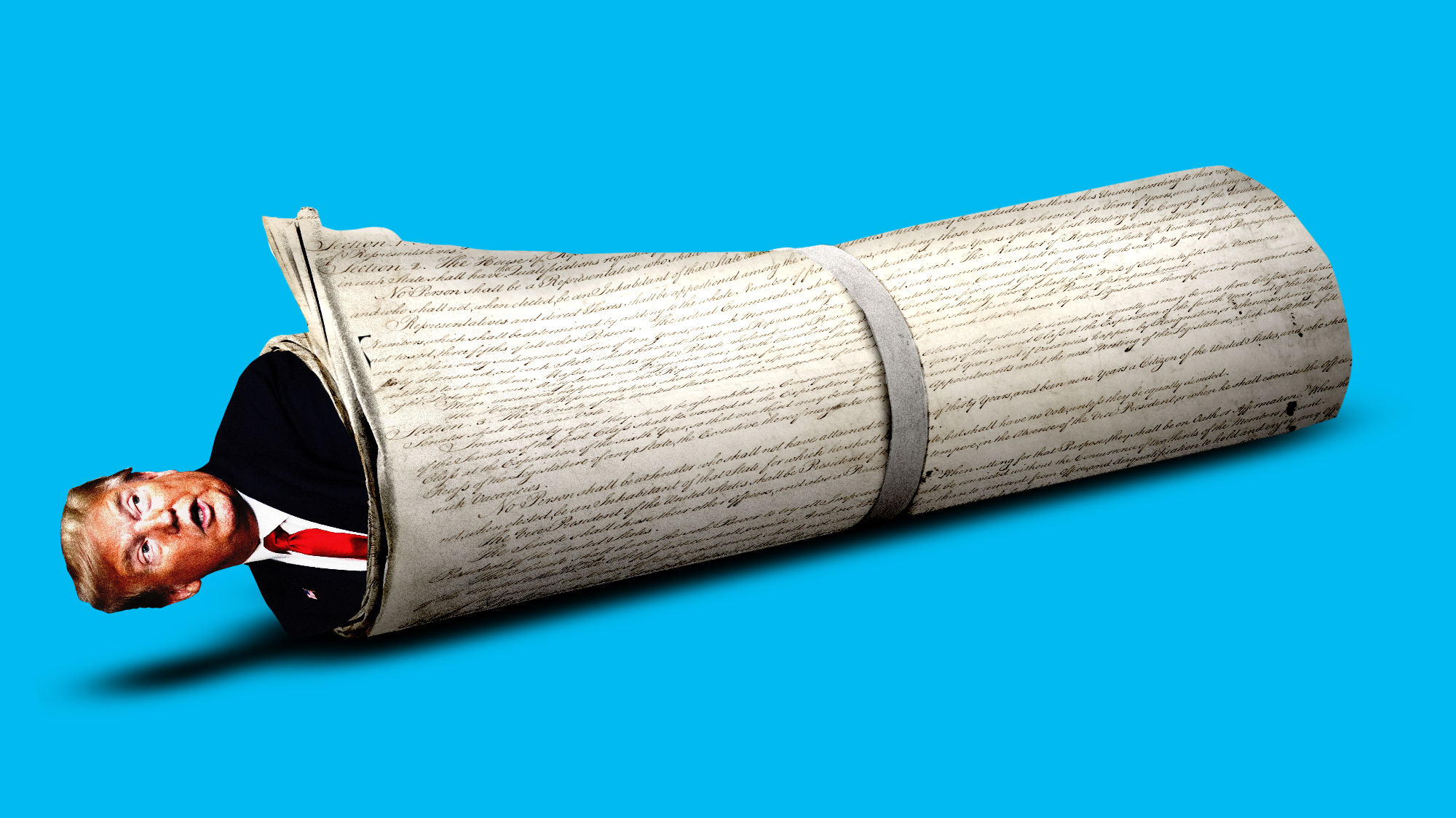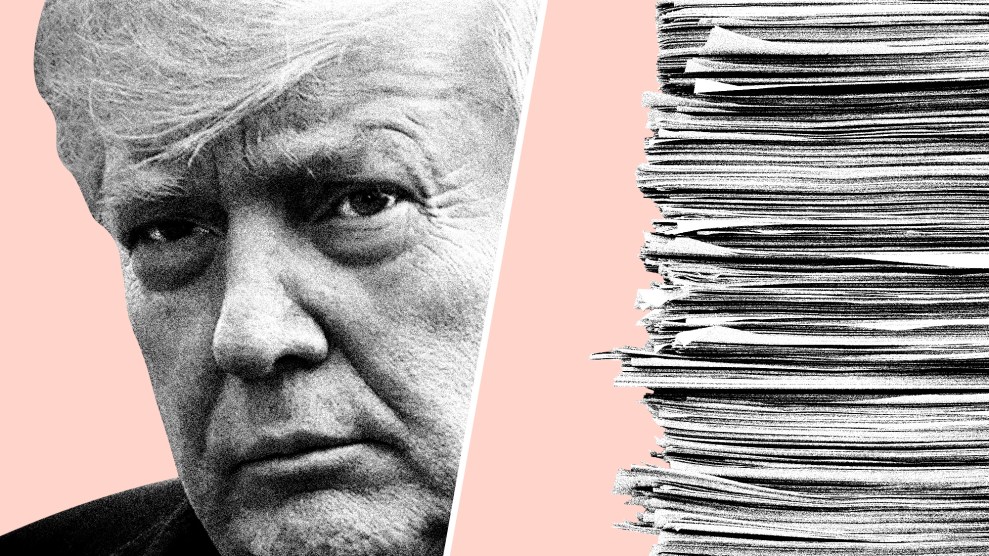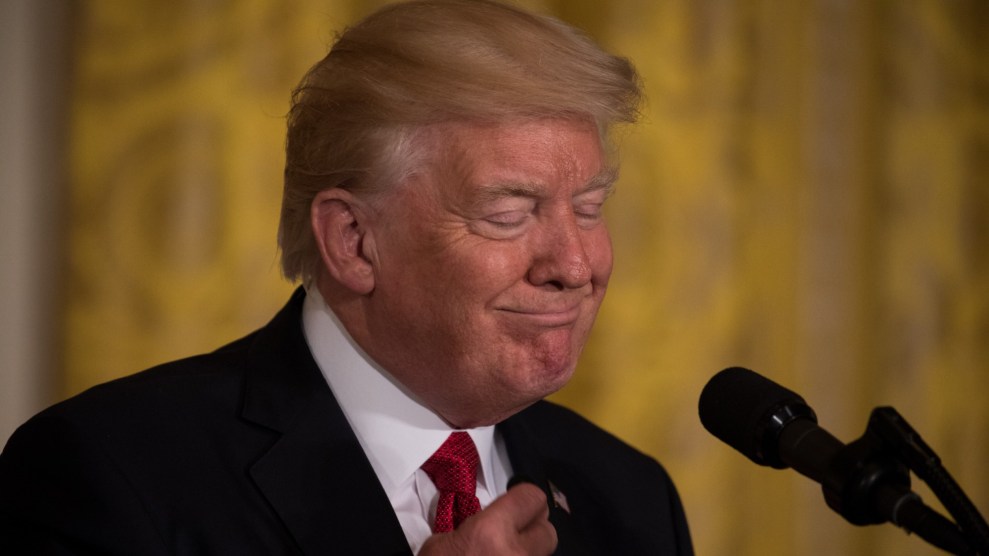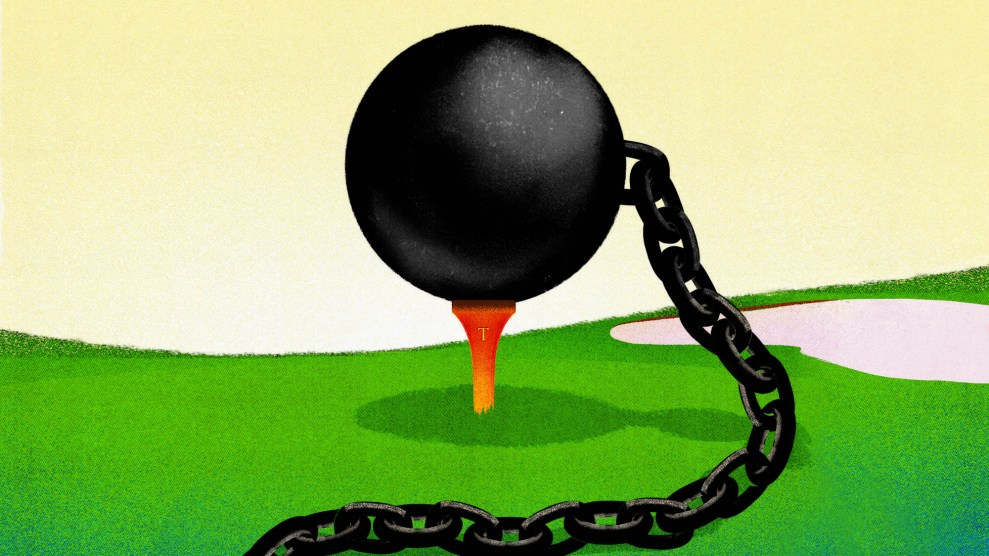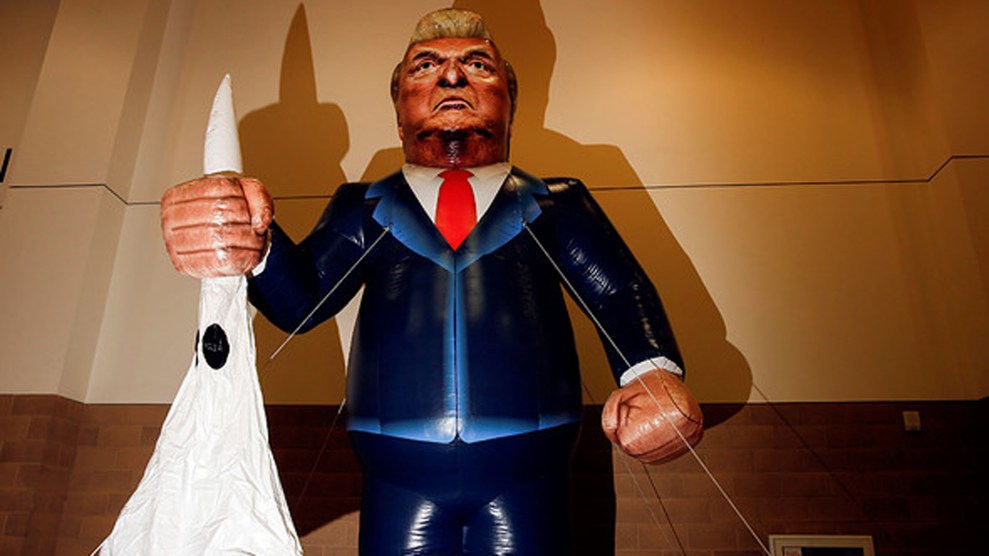In the final week of the 2020 elections, a Biden campaign bus departed San Antonio on the last afternoon of a three-day Texas tour. The bus had already encountered intimidation and harassment from Trump supporters on the state’s highways, where so-called “Trump Trains” stalked the bus. But on the final day, the Trump Trains planned to go big. As the bus headed down Interstate 35, dozens of trucks bearing Trump flags converged.
At first, police cars held them at bay. But when the bus crossed into the city of San Marcos, their escort receded and no new help arrived. The trucks formed a moving barrier and forced the bus to a crawl, trying to push it onto the shoulder. One Trump supporter guided his truck into the vehicle of a staffer following the bus, causing a collision. By the time the bus finally escaped by making a last-minute exit from the highway at 70 miles per hour, according to those on board, its passengers and others driving alongside it had been made to fear for their lives and forced to cancel the day’s planned events.
Video of the incident soon went viral on Twitter, but didn’t fully convey the terror of the attack. When President Donald Trump tweeted it along with the words “I LOVE TEXAS!,” it had a fight song added for effect. He called the attackers “patriots.”
A few months later, on January 6, he rallied “patriots” to march on the Capitol and, after they sacked it, told them, “We love you.” The January 6 insurrection and the assault on the bus are just two recent incidents that have pushed prosecutors, civil rights lawyers, and public interest groups to seize on a statute enacted some 150 years before Congress’ doors and windows were breached. The law commonly known as the Ku Klux Klan Act was passed in 1871, at a time when the United States also confronted a rise in political violence threatening democratic governance. The sweeping law took aim at Southern vigilantes who used intimidation and violence to thwart not only their political opponents, but courts and federal officers trying to maintain the rule of law. Today, a statute crafted to keep the Klan from imposing its political agenda is being used against modern violent groups such as the Oath Keepers and Proud Boys and those who conspire with them—including Trump supporters. If the courts see fit, the law could become a powerful tool to defeat the rising tide of violence and election subversion threatening American democracy.
Since Trump came to and left office, the Klan Act has fueled a wide range of litigation, including three voter-suppression cases, a lawsuit against perpetrators of the deadly Unite the Right rally in Charlottesville in 2017, two over the highway assault in Texas, and seven cases against perpetrators of January 6. Some target Trump himself. Most recently, Ukraine expert Lt. Colonel Alexander Vindman sued Trump and three close associates under the Klan Act for reprisal and intimidation surrounding his testimony during Trump’s first impeachment.
The Klan Act was Congress’ response to extreme political violence in the South, where former Confederates were bent on destroying the Republican Party and maintaining the antebellum racial hierarchy that Reconstruction sought to dismantle. “It was guerrilla warfare,” says Robert Kaczorowski, a professor emeritus of law and legal history at Fordham University School of Law, and “the Klan and other organizations were paramilitary wings of the Democratic Party,” then the party of white supremacy. Across the South, Black people and their white Republican allies lived in terror of violence. Black men slept in the woods to hide from Klan raids. In South Carolina, when white confederate sympathizers failed to dislodge Republicans in 1870 elections, the Klan essentially seized control of the northwest corner of the state with a stream of raids, beatings, and murders.
Across the South, the Klan and other white supremacist groups sought to undo Reconstruction by attacking Black people, white Republicans, and local Republican leaders. When prosecuted, they did not allow the court system to get in their way; witnesses were intimidated, judges were murdered, and juries were generally filled with Klan members or sympathizers. In Reconstruction: America’s Unfinished Revolution, 1863–1877, historian Eric Foner describes a massacre in Meridian, Mississippi, shortly before Congress enacted the Klan Act, that illustrates the violent lawlessness that reigned: “Three black leaders were arrested in March 1871 on charges of delivering ‘incendiary’ speeches. Firing broke out at their court hearing, the Republican judge and two defendants were killed, and a day of rioting followed, which saw perhaps thirty blacks murdered in cold blood, including ‘all the leading colored men of the town with one or two exceptions.’”
The same month, the Republican governor of South Carolina appealed to President Ulysses S. Grant for assistance, unable to control the violence in his state. Grant asked Congress to step in. In the face of such violence, legislators passed the Ku Klux Klan Act in April, crafting it to restore order and democracy to the South with a force that met the breadth of the problem. The act banned conspiracies to interfere with, intimidate, or harm federal officers in the course of their work, citizens on account of their support for federal political candidates, and witnesses in federal court proceedings. It also forbade conspiracies to overthrow the federal government and to prevent the execution of the law. Importantly, the law created civil as well as criminal liability, which gave citizens the right to sue their aggressors and win large cash settlements.
The law also granted the president the authority—which expired after one year—to temporarily declare martial law and suspend habeas corpus. In October 1871, Grant used this provision to send troops into South Carolina where, as Army Major Lewis Merrill had reported, Klan rule had created a “carnival of crime not paralleled in the history of any civilized community.” Meanwhile, Grant’s attorney general, Amos Akerman, used the new law to prosecute the Klan across the South. “By 1872, the federal government’s evident willingness to bring its legal and coercive authority to bear had broken the Klan’s back and produced a dramatic decline in violence,” Foner wrote. “So ended the Reconstruction career of the Ku Klux Klan.”
But when the government turned away from Reconstruction soon after, enforcement ceased. A decade later, the Supreme Court ruled that its criminal penalties for conspiracy to deprive people of equal protection was unconstitutional; a decade later, as the country entered an era of racist voter disenfranchisement, Congress repealed the Klan Act’s criminal penalties that protected voters targeted for their support or advocacy for federal candidates. With few exceptions, the Klan Act lay fallow from the time of Reconstruction until the Trump era.
“In the late 20th and early 21st century, we didn’t live in a world where we routinely had the problem of organized violence interfering with federal governance. We had a pretty stable system,” says Richard Primus, a legal history scholar at the University of Michigan Law School. “Because the Trump administration presented the country with threats to normal constitutional government of a kind that we had not seen in a long time, a set of tools that hadn’t been apropos for a long time became apropos again.”
The Klan Act seems to outlaw kinds of political violence pushed by Trump and carried out by his supporters, from intimidating voters and those campaigning for office to attacking federal officers performing their duties—including during the Capitol riot. Primus, who co-authored a law review article before the attack arguing that the act could play a role targeting modern-day election interference, now says that “the law they wrote covers the January 6 cases pretty well.”
“The January 6 cases are about trying to get legal relief against a set of people who used force to interfere with the orderly processes of federal governance—which is what the Klan Act is all about,” he says.
When the Unite the Right rally terrorized Charlottesville, Virginia, in August 2017, attorney Roberta Kaplan had just started a new law firm and saw an opportunity to use the Klan Act’s authorization of civil suits and penalties to hold the perpetrators accountable. She and her colleagues flew in from New York soon after to put together a case representing people who had been harmed during the violent demonstration. With the help of Integrity First for America, a civil rights nonprofit, and her friend Karen Dunn, a partner at the law firm Paul Weiss, it took Kaplan’s team four years to reach trial. In November, the jury found the rally organizers guilty of conspiracy to incite racially motivated violence and awarded the victims $26 million. While the jury deadlocked on the Klan Act violations, it convicted on substantively identical state claims, making it a demonstration of the potential of using the courts to extract crippling financial penalties from people or groups that push racial terrorism.
Using the Klan Act to go after people who were fighting to preserve Confederate monuments—literally trying to protect symbols of white supremacy—has poetic justice. Kaplan calls the defendants in her case the “modern-day equivalent” of the Ku Klux Klan, and describes how their racism and anti-Semitism permeated proceedings. “I never thought I would go to a trial where it’s no exaggeration for me to say that Mein Kampf came up every day.”
But unlike the Ku Klux Klan of old, she points out that the men in her trial “rather than having to meet in the woods, they’d meet on social media.” While the shift from the forests to the internet let white supremacists plan and grow their ranks nationwide, it also left digital records that have proven critical to today’s Klan Act cases. After the Unite the Right rally, leaked logs from the Discord chat app helped Kaplan and her colleagues build their case. The Klan Act bus cases in Texas and in response to January 6 likewise rely on the massive amount of online evidence—including Trump’s tweets—that conspirators shared prior to and during the attacks.
In December, Karl Racine, the attorney general of Washington, DC, used social media records in filing a suit under the Klan Act against the Proud Boys, Oath Keepers, and more than two dozen individual perpetrators of the January 6 attack, detailing how the city and its police officers were injured. The case seeks punitive monetary damages, and Racine has touted its potential to destroy these white supremacist groups and individuals by hitting “where it counts” and taking away their money. The verdict in Charlottesville “gives us a lot of momentum,” Racine said shortly after filing.
The crafters of the Klan Act’s provisions prohibiting interference with federal agents performing their duties aimed to protect agents of the law who were arresting, prosecuting, and trying Klan members. They did not envision that the agents could be members of Congress. But by invading the Capitol to stop Congress and the vice president from certifying the 2020 election results, the January 6 rioters and co-conspirators—including Trump—opened themselves up to suits from anyone in the building doing their federal duty.
Both members of Congress and Capitol Police officers have taken the opportunity to file pending suits. Weeks after the insurrection, 11 Democratic representatives sued Trump, Giuliani, the Oath Keepers, the Proud Boys, Proud Boys leader Enrique Tarrio, and a new corporate entity supporting him and the group, in a separate lawsuit brought by the NAACP. Shortly thereafter, Rep. Eric Swalwell (D-Calif.) sued Trump, Donald Trump Jr., Rudy Giuliani, and Rep. Mo Brooks (R-Ala.) under the act for conspiring to stop the election certification by harming members of Congress. In April 2021, three Capitol Police officers brought Klan Act suits against Trump, followed in August by a suit from eight Capitol Police officers against Trump, the Proud Boys, Oath Keepers, and multiple individual insurrectionists. The cases rely on the perpetrators’ significant online trail as well as evidence that Trump and his associates not only planned the rally, but monitored social media channels where attack planning took place. On February 18, DC District Court Judge Amit Mehta—simultaneously considering the suits from members of Congress and two of the Capitol Police officers—ruled that Klan Act charges against Trump, the Oath Keepers, and Tarrio could move forward. He dismissed the charges against Giuliani and Trump Jr.
In Texas, the two Klan Act cases responding to the harassment of Biden’s campaign bus could showcase the legal potential of other parts of the law, including its remaining civil provisions protecting those engaged in “support or advocacy” of a candidate for federal office. The bus attack, which threatened people working on a presidential campaign and forced the cancellation of planned events, would seem to be a textbook example of such a violation. Once the bus had escaped the Trump Train, its driver took it out of Texas—literally driven out of the state by fear and the threat of violence. If modern-day vigilantes undertake similar intimidation of campaigns and voters, a ruling against the harassers could be a blueprint to combating it.
A second Texas case, filed by the same four people—the driver, a surrogate, and a staffer on board the bus, as well as a volunteer driving alongside—against police officials and the city that refused to protect the bus is being brought under provisions that could prove to be an even more powerful tool against future violence or election interference. While other jurisdictions’ police forces kept the pro-Trump drivers at bay, San Marcos law enforcement officials decided not to protect the bus. While in San Marcos, and “without police to temper them, Trump Train drivers surrounded the bus on all sides, playing a madcap game of highway ‘chicken,’ coming within three to four inches of the bus,” the complaint alleges.
No help came, despite phone calls to the city’s police from campaign staff and volunteers both on and off the bus, as well as unaffiliated drivers who witnessed the harassment. “We’re not going to escort a bus,” one defendant, a corporal with the San Marcos Police, told the emergency dispatcher on a recorded emergency call.
The decision to do nothing, alleges the lawsuit, is prohibited under the Klan Act, which includes an affirmative duty to act requiring anyone with knowledge of and power to help prevent an illegal conspiracy under the law to take action to prevent it. In order to root out violent conspiracies and election interference in the late 1800s, “Congress specifically imposed a duty on all Americans to protect targets of political intimidation and violence in federal elections,” the suit states. The provision may be especially potent when brought against law enforcement in areas where, as in the Reconstruction era, local officials with the knowledge and ability to prevent such harm may be inclined to stand aside. The complaint outlines ample reasons city officials should have known they needed to act: Not only were they warned directly at least 24 hours ahead of time by a Biden campaign affiliate and entreated repeatedly for assistance as the attack unfolded, advance coordination had publicly taken place on Facebook, was circulated by its planners, and reported in the media. At events and on the highway over the preceding two days, Trump supporters had already pursued and harassed the Biden campaign—including at the urging of Donald Trump Jr.
The Texas bus case is not without its own historical parallel. In the 1980s, a Freedom Rider who was severally beaten in Alabama in 1961 successfully sued the federal government under the Klan Act after he learned that FBI agents had been aware of plans to attack the bus he and other activists were riding but did nothing to stop it. Several of the modern Klan Act cases make a the same claim in their suits, including Washington, DC’s case against organizers of the January 6 attack. Those planning a conspiracy, these suits argue, are also liable under the law for failing to try to stop it. The argument demonstrates how the law’s uncommon duty to act provisions could spread liability to a wide number of people who, in the future, might fail to take action to prevent a conspiracy targeting an election with acts of intimidation or violence.
On January 6, 2021, Kevin Seefried attended Trump’s “Save America” rally and followed the president’s instructions to go to the Capitol, where he entered carrying the Confederate battle flag. Pictures of him holding it outside the Senate chamber quickly became some of the most indelible and disturbing images of the attack. As William Blair, professor emeritus of history at Penn State, told the New York Times shortly afterward, “the Confederate flag made it deeper into Washington on January 6, 2021, than it did during the Civil War.” The police officers who defended the Capitol that day, including several now using the Klan Act to sue their attackers and Trump, were subjected to racial slurs.
Charlottesville and January 6 not only showed that white supremacist groups play a significant and violent role in Trump’s base of support, but also that the country’s struggle to remain democratic looks in part like a struggle not to fall backward into Jim Crow. With the political and racial violence that threatened democracy 150 years ago rising again, the Klan Act is getting a second chance to quell this latest resurgence.
